Vadakkumnathan Temple is one of the important and oldest temples of Kerala. It is situated in Thrissur, an important religious town of the state. It is considered to be the first among the 108 Shiva temples established by Parashuram in ancient Kerala The temple is dated to be more than 1000 years old.

Origin of the Vadakkumnathan Temple
As per the legends and folk tales, this temple was set up by Parashurama. He is considered as the sixth avatar of Shri Vishnu, born to Rishi Jamadagni and Renuka. The couple had a cow called Surabhi which fulfilled all desires. Once a king requested Rishi Jamadagni to hand over the cow to him but he refused. So, when the rishi had gone out for bathing, the king stole the cow. Parshuram on learning about the robbery was furious and went in search of it. He had to fight with the king. Finally, he killed the king and got the cow back to the ashram.
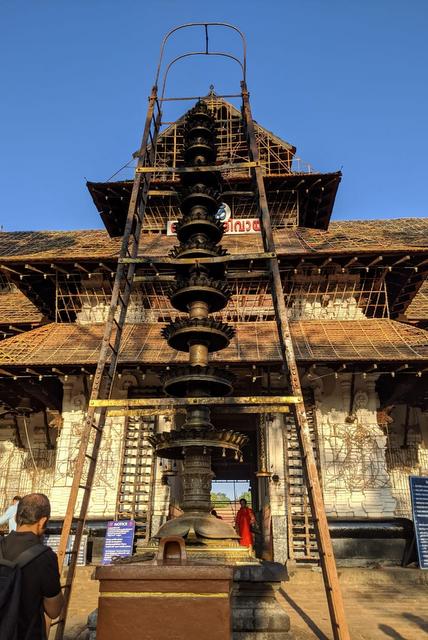
He narrated the entire incident to his father, who asked him to amend his sin by going on a pilgrimage. He returned after the pilgrimage and found that the ashram was destroyed and his father was killed by the Kshatriya kings seeking revenge. In retaliation, he picked up his ax and killed many Kshatriya rulers. It is said that he eliminated the Kshatriya race twenty-one times. In order to expiate his sins, he performed a Yagna and threw his ax into the ocean. The result of which western coastal plain, now known as Konkan was reclaimed from the sea.
Local Legend
As per the local legend of Kerala, he was asked by various Rishi Munis to give them some secluded land after the Yagna as Dakshina. He hurled a Surpa or winnowing fan into the sea and a landmass hurled out of it. The landmass is present-day Kerala which was then also known by the name Surparaka. Then he went to Kailasa. Requested Shiva and Parvati to take his abode in the new land and bless it.

It is believed that Shiva along with Parvati, Ganesh, and Kartikeya obliged him and came with him. He chose the spot which is now present-day Thrissur as his seat. Later Shiva and his family disappeared. Parasurama saw a radiant light emanating from a Linga at the base of a huge banyan tree. This is the place where Shiva manifested himself as the main idol. Now known as Shri Moolasthanam, outside the west gopuram of the temple.
Do read: Guruvayur Temple – Lord Krishna’s abode in God’s own country
Vadakkumnathan Temple Architecture
The idol was said to be at the base of the Moolasthanam for many years. Later the rulers of the Kingdom of Cochin decided to build a temple and place the idol inside it. The temple is situated on a small hillock at the center of a circular maidan. Locally called Tekkinadu (teak forest), overlooks the city. Spread across 9 acres, enclosed by a huge stone wall with four magnificent gopurams in the four cardinal directions i.e. east, west, north, and south. The main entrance for devotees is through the east and west gopuram.
Whereas north and south, gopurams remain closed. The south gopuram is opened only during Thrissur Pooram, an important festival celebrated in the month of April.
Gopuram
The gopurams are multi-storeyed structures made with granite and tiled roof. This structure of the temple is a typical temple structure that is followed in Kerala, with a wood and tiled roof like a pagoda. The main shrine is centered inside a multi-shrined courtyard. Along with shrines dedicated to Parvati, Shankar Narayan, Sri Rama, and Ganesh, which are surrounded by a wall smaller than the outer wall. The inner temple complex can be reached from the outer complex through a corridor called “Chuttambalam”.
As one crosses the corridor, there is a mural painting of Vasukishayanam (Shiva sleeping on serpent king Vasuki, similar to Vishnu’s Anantshayanam) on the northern wall. It is behind the Nandi and Nrithanath, the painting of dancing Shiva with 16 hands. These two paintings are also worshipped along with the deities.
Linga
The shrine of Shri Vadakkumnathan is circular in shape with one roof and pillars. The Linga of Vadakkumnathan is not visible as it is covered with mounds of ghee due to regular Abhishek conducted over so many years. It is said that the ghee never melts. Neither in the summer season nor due to the warmth of the Diyas lighted inside the sanctum sanctorum. There is no foul smell either inside the temple due to the presence of so much old ghee.
The Linga is embellished with thirteen crescents of gold. It has three serpent hoods on top. The deity of Parvati is in the same shrine at the back of the temple. Both the deities do not face each other. Since this image is made of wood, Abhishek is done only with turmeric. The Vigraha has three eyes and is decorated with ornaments and silk cloth.
Sri Ram Shrine
There is a two-storeyed Sri Ram shrine located inside the courtyard that faces the west direction. The wall of the temple is decorated with beautiful mural paintings. Between these two shrines is located a circular shrine dedicated to Shri Shankarnarayan which faces the same direction as the other two shrines. The Vigraha of Shankarnarayan is a combination of both Shiva and Vishnu. It has four arms that carry a trident, a hatchet on the right side, and a conch shell, a Gada on the left side.
The walls are covered with murals depicting the story of Mahabharat. The architecture of these three shrines is said to be of “Vritta” or a circular plan with a conical roof. There are three wooden Mukhamandaps in front of these three shrines.
Mahaganapati Shrine
Between Vadakkumnathan and Shankar Narayan is the shrine dedicated to Mahaganapati facing the east direction. That is towards the temple kitchen, which is situated behind the Shankarnarayan shrine. The Vigraha is four-armed. Towards the northern side is another deity called Vettakkorumakan (Shiva in hunter form) which is supposed to be the guardian of the temple. Bali stone is made of brass and stone images of prostrating men can be seen everywhere on the ground.
The temple compound between the outer wall and the inner wall houses a number of shrines. There are many peepal trees scattered inside the outer courtyard. The compound has a Pradakshina path. There is a particular laid down process to be followed while doing the Pradakshina around the temple.
Do read: Chottanikkara Temple in Kochi that cures Mental problems
Shrines and structures in the outer compound
The different shrines and structures present in the outer compound are:
Koothambalam or Natyagriha
It is a huge wooden structure where the ancient dance and art forms of Kerala like Koothu, Koodiyattam, and NangyarKoothu are performed annually.
Gopalkrishna or Gosalkrishna
Dedicated to Krishna as a cowherd. It is said that there used to be a Goshala too.
Shara Teertham
There is a deep well on the northern side. A legend says that after killing Jayadratha in the Mahabharat War, Arjun came here for penance. He created the well by shooting an arrow and filling it with water from River Ganga.
Vrishabh or Nandikeshwar
This temple is dedicated to Nandi, the Vahan of Shiva. It is situated on the North Westside. The deity is in a sleeping position. Hence it has to be woken first by clapping our hands. Devotees offer a thread from their dress as a practice.
Parashuram
On the northeast corner is a platform dedicated to Parashuram. It is said that he disappeared from this place after completing his duties. A Diya is lighted there.
Simhodara
He is one of the Gana of Shiva who was assigned the duty to find a suitable place for Shiva to reside after Parashuram requested him to reside in Kerala. Simhodara found a suitable place and was taking a rest when Shiva came and kicked him out of the inner courtyard. Since then it is said that he is residing at this place. Devotees pick some small stones from the ground and place them on another stone locally called Balikallu, on the northern side of this temple.
This stone is associated with the legend of an old and poor Brahmin visiting Kashi with the help of Simhodara. There is a small triangular hole in the inner wall through which devotees can see the temple of Vadakkumnathan.
Shastha Temple
On the southeast corner, a small shrine has been constructed for Shastha or Shri Ayappa. Behind the temple, there is a place full of grass. It is believed that some parts of the soil from the Sanjeevani mountain fell down here while Hanuman was carrying it to Lanka.
Vyasa Shila
Under a peepal tree is a platform with the shrine of Vyasa Rishi, the creator of Mahabharata. Devotees write “Om Shri Mahaganapataye Namah” on the platform with their fingers as a pen.
Adi Shankaracharya
There is a shrine dedicated to Adi Shankaracharya, who had spent some days here. There is a legend about his birth associated with this temple.
Sambuthara
There is a platform on the southeast corner from where one can worship Shri Chidambaram while facing east and Shri Rameshwaram facing south. It is said that the “Nataraja” dance of Shiva in the Chidambaram Temple gets reflected in Rameshwaram too. It is said to have been viewed by Anantha, the 1000-hooded serpent from this point.
Ammathara
From this platform, one prays to “Oorakathamma”. Said to be another form of Kamakshi, settled in Oorkam, 10 km from the temple. Shri Koodalmanikyaswamy (Bharata, brother of Shri Ram), whose Murthy is installed at Irinjalkuda, 20 km south of the temple. It is believed that they both visit this platform to pray to the deities inside the temple.
Do read: Kalady – Birthplace of Adi Shankaracharya near Kochi
The procedure of worshipping inside the Temple
Many devotees follow a certain procedure for circumambulation or Pradakshina as laid down by Adi Shankaracharya while visiting the temple. There are two different procedures for worshipping in both the outer and the inner courtyard.
For the outer courtyard: The procedure to be followed is written near the Koothambalam in English and Malayalam. The order is as below:
- Shri Moolasthanam: outside the west Gopuram.
- Goshalakrishnan
- Nandikeshwara/Vrishabha
- Parashuram
- Simhodara
- Kashivishwanatha: to be prayed by facing north from Simhodara shrine.
- Sambhukumbham: turn towards the inner wall and through the gap on it view the Kalash of Shri Vadakkumnathan.
- Sambhuthara: pray to Chidambaram and Rameshwaram.
- South Gopuram: pray to Kodungaloor Devi facing south.
- Ammathara: pray to Oorakathamma Devi and Koodalmanikya Temple.
- Look towards the Kalash of Vadakkumnnathan, Shankaranarayanan, and Sri Rama.
- Vettakkorumakan: the hunting Shiva.
- Vyasashila and write ‘Om Shri Ganapathaye Namah’.
- Ayyappa or Shastha.
- Behind the temple, at the place where Sanjeevani soil had fallen down.
- Samadhi of Adi Shankaracharya
After the parikrama or Pradakshina of the outer compound, one enters the inner courtyard through the “Chutambalam” and prays to:
- Vrishabha
- Vasukishayanam painting. Also known as Phanivarashayana. One of the rarest murals in which Lord Shiva is depicted resembles Lord Vishnu’s Ananthashayana form.
- Nrithanath painting
Do read: Kerala Snake Boat Race – Rhythm of Action on Backwaters
Worshipping Sequence in Inner courtyard
The sequence to be followed for worshipping inside the inner courtyard is as follows. Note that repeat visits are part of the sequence:
- Shri Vadakkumnnathan
- Parvati
- Shri Ganesh
- Shri Shankarnarayan
- Shri Ram
- Shri Shankarnarayan
- Shri Ganesh
- Parvati
- Shri Vadakkumnnathan
- Shri Ganesh
- Shri Shankaranarayana
- Shri Ram
- Shri Shankaranarayana
- Shri Ram
- Shri Shankaranarayana
- Shri Ganesh
- Parvati
- Shri Vadakkumnnathan
Legends associated with the Vadakkumnathan Temple
There are many legends associated with the temple. One such legend is connected with the birth of Adi Shankar. Sivaguru and Aryamba of Kaladi were childless for a long period of time. They visited Vadakkumnathan in Thrissur and spent their days in puja and meditation. One day, Shiva appeared in their dreams and blessed them. But he had one condition – to choose between a learned and intelligent son who would live a short life and a mediocre son who would live a long life.
They chose to have the former one. Within a year a son was born to them. Whom they named “Shankar” as a mark of respect for God. A structure has been built as Shankar’s Samadhi in the outer complex of the temple.
Mural painting of Nrithanath
Another legend is about the mural painting of Nrithanath or Nataraja inside the temple complex, near the Chuttambalam. A devotee of Shri Vadakkumnathan was a famous mural painter and painted a beautiful picture of Nataraja for three months. But on the next day, a Namboothiri devotee washed the picture with the water from his Kamandal that he was carrying for puja. This incident happened for the third time when the painter decided to complain to the temple authorities.
When the Namboothiri heard about it, he consoled him saying that I can paint a better picture in one day and you all would be surprised to see what happens thereafter. Everybody came to watch him paint his masterpiece. When the picture of Nataraja was completed, it came to life and people saw him moving his eyes and dancing. The painting became static after a minute. Hence, the painting is worshipped since then.
Bless the Devotee
Shri Vadakkumnathan is said to “bless the devotee as he prays”. Once such an incident happened with an old and weak Brahmin. He heard that a Namboothiri was going to Kashi. He had a deep desire to visit Kashi. So, he requested him to take him along with other people, who were accompanying him. Since in those days, travel to Kashi was on foot and very painful, the Namboothiri rejected his request. The old Brahmin prayed to Shri Vadakkumnathan and it is said that God himself ordered Simhodara to take the Brahmin to Kashi.
He took him through a tunnel to Kashi. The next day, as the Brahmin was bathing in one of the ghats, the Namboothiri saw him and asked him how he managed to reach Kashi. He replied that he prayed to Shri Vadakkumnathan and by his grace only he could reach here. There is a stone kept on the spot of the tunnel as Devi Parvati ordered Simhodara to close it. Devotees keep some stone on top of it as practice.
Similarly, there are many more legends in honor of Shri Vadakkumnathan.
Do read: Visit Padmanabhaswamy Temple, Thiruvananthapuram
Temple Festivals
The major festivals celebrated in the Vadakkumnathan Temple are as follows:
Shivaratri
It is the main festival of the temple that is celebrated in the month of Feb-March. Many cultural and musical programs are organized on the temple premises. The entire temple complex is lit with lights on this day. The temple is open throughout the night. Continuous Abhisekha is done with coconut water and ghee. The deity is not taken out for any procession.

Aanayoottu
One of the biggest festivals is held in the temple, where elephants are fed on that day. It falls on the first day of the Malayalam month Karkkidakam i.e. in the month of July. A Mahaganapati Homa is organized on that day. Many people visit the temple to worship and feed a large number of elephants, gathered for this festival. This is because elephants are associated with Shri Ganesha. A Gaja pooja is performed once every four years interval.

Thrissur Pooram
It is the mass gathering of different deities of the nearby temple every year in the temple ground. It is held in the Malayalam month of Medam which falls in April. This festival is the grandest of all Pooram’s that are held in the state. Pooram denotes the Nakshatram or star of the Malayalam month in which the festival is celebrated. On this day, the temples in central Kerala hold their annual festival of honoring their deities by conducting processions on caparisoned elephants and an ensemble of percussions.
It begins in the month of November and extends up to May. Although there are many festivals celebrated across this period, the most important one is the Thrissur Pooram.
Shakthan Thampuran
It is said to be about 200 years old. Said to be the brainchild of Raja Rama Verma popularly known as Shakthan Thampuran, who was the king of Cochin. He unified all the ten temples situated around the Vadakkumnathan Temple. And took various steps to celebrate it as a mass festival. The entire procedure of the Pooram celebration was planned by him. It is followed till today without any change.
He classified the temples into two groups – the eastern and western groups of temples. All these temples send their processions to Shri Vadakkumnathan to pay their respect. It is a seven days festival that starts with the flag hoisting at respective temples and the display of fireworks to announce the commencement of the festival. Both the groups of temples display their ornaments and caparisons of their respective elephants on the fourth and fifth day prior to the Pooram.
Neithikavvu Bhagavathy Devi
On the previous day of the festival, Neithikavvu Bhagavathy Devi from the western group of temples reaches the Vadakkumnathan Temple. Pays her obeisance to Shiva opens the south gopuram, and then goes to the Moolasthanam. There she is received by the Cochin Dewaswom Board representative. Then a conch is played thrice to announce the Pooram.
36-hour-long Pooram follows a strict schedule and route through which the deities come to pay their obeisance to Shri Vadakkumnathan in their caparisoned elephants. The day starts with the ceremonial entrance of each of the deities as per their schedule. The Festival ends with the final display of fireworks. That is such a spectacular sight. People come from far-off places and are awake the whole night to witness the grand finale of the event.
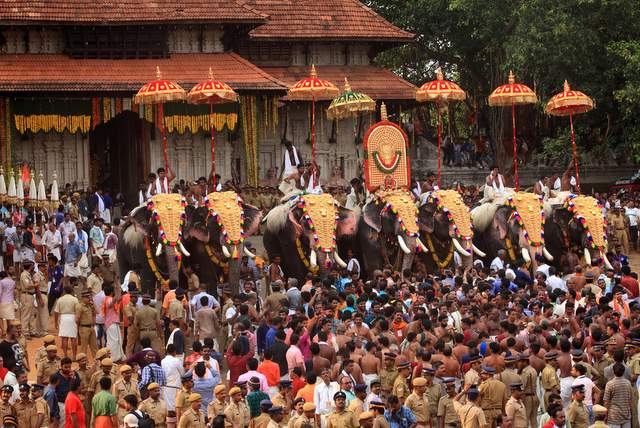
Another attraction, organized since 1964, is one of the biggest trade fairs of South India. Here both the Central and State Govt put up pavilions and stalls to display their various products.
Do read: Kalamezhuthum Pattum – The temple ritual of Kerala
Travel Tips
- A strict dress code is followed. Men are to wear a dhoti and enter shirtless. Women can wear a saree, a long Kerala skirt, and a top or salwar kameez.
- Vadakkumnathan Temple timings are 4 to 10 am. Then from 4:30 to 8:30 pm.
- There are many hotels near the temple, so accommodation is not a problem.
- KSRTC bus services run from various parts of the state and a few interstate locations.
- Photography is strictly prohibited inside the Vadakkumnathan temple complex.
- The best time to visit is during Thrissur Pooram. Book hotels beforehand as there are lots of visitors during this festival.
- Thrissur has a railway station well connected with important cities.
- Kochi and Calicut are the nearest airports.
- Other important places nearby that you can visit are Kalady, Guruvayur, etc.
This is a post by Shruti Mishra under Inditales Internship Program. Unless credited all the photographs in this article belong to the author.



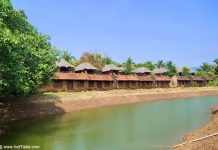

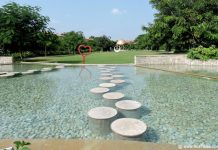


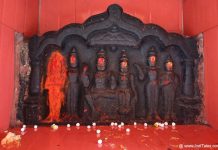






Wow it’s amazing thanks for share a wonderful blog…
Thank you for liking it
One of my TO VISIT list is this. Due to Pandemic I missed the chance and till now haven’t seen the place but I am waiting for the moment to visit that place during festive occasion. Hope, my dream will come true soon. And, Thanks for this wonderful Blog and this made me feel to go there soon.
It’s wonderful to read your blog, ‘Vadakkumnathan Temple at Thrissur Pooram in Kerala.’ You explain the temple’s history, traditions, and rituals in detail, giving readers an in-depth review of everything.